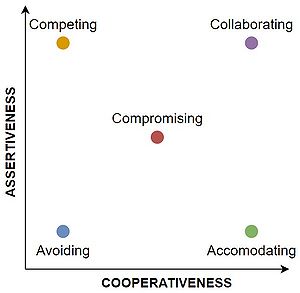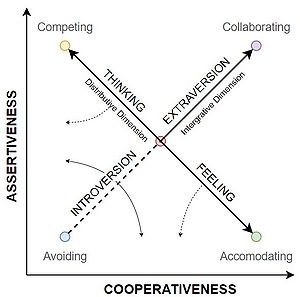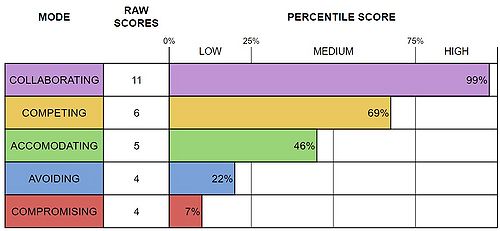Conflict Management using the Thomas-Kilmann Conflict Mode Instrument (TKI)
Contents |
Abstract
Conflicts are common when working with other people on projects, programs, and portfolios. They should not necessarily be avoided since they can provide great value to team members and improve the final product. However, it is of great importance that team members and not least the project manager knows how to manage the conflicts appropriately to avoid that the conflict escalates and becomes inconvenient to the work [1]. (Project Management Institute, Inc. (PMI), 2021)
This article will introduce the Thomas-Kilmann conflict mode instrument (TKI), developed by Kenneth W. Thomas and Ralf H. Kilmann. The purpose of the tool is to identify a person’s most used conflict handling modes and learn to manage conflicts (Kilmann, 2011).
The article will also introduce the correlation between the Myers-Briggs Type Indicator (MBTI) assessment and the TKI assessments, meaning that certain personality types tend to use certain conflict handling modes more frequent (Kilmann & Thomas, 1975).
Big Idea
Conflicts in project management
When working with projects, several competencies are relevant for the project managers to have. Technical competencies, to be able to direct, manage, plan, and deliver a project. (4). Business competencies, to be able to manage organizational, contractual, and external environment. And finally behavioral competencies, associated with leadership, team building, negotiation, and conflict management. Conflicts are defined as _____.
A lot of people are involved on projects which makes a dynamic environment, and the projects are often challenged with budget, scope, schedule, and quality (1). These factors make conflicts common on projects– and almost inevitable. Trying to avoid conflicts is not necessarily the best solution, since it can restrict the communication between the parties involved and lower the creativity. When addressing conflicts appropriately, they can be healthy and lead to a more productive process, better decision making and stronger solutions. The trust among project team members can also increase and cause a deeper commitment to the project. However, if conflicts are addressed inappropriately, they are unhealthy, can escalate, and can affect the project team members with reduced morale, motivation, and trust.
The TKI assessment
The Thomas-Kilmann Conflict mode instrument (TKI) is developed by Kenneth W. Thomas and Ralf H. Kilmann. It is a personality assessment, which examines an individual’s behavior when dealing with a conflict. The assessment identifies the relative frequency an individual tends to use each of the five different conflict-handling modes – competing, collaborating, compromising, avoiding, and accommodating. The purpose of the assessment is to become aware of the conflict handling modes an individual tends to use – consciously or unconsciously – and to learn how to purposely choose and use the right conflict handling mode for different conflict situations. An individual’s conflict behavior – and thereby the five conflict handling modes - can be categorized along two basic dimensions - assertiveness and cooperativeness. Assertiveness refers to an individual’s attempt to satisfy his or her own needs. Cooperativeness refers to an individual’s attempt to satisfy other’s needs. Each of the five conflict handling modes can be placed along the two dimensions.
Competing is high on assertiveness and low on cooperativeness. This means, that an individual tries to satisfy his or her own concerns at the other person’s expense.
Collaborating is high on both assertiveness and cooperativeness. This means that an individual tries to fully satisfy both his or her own concerns and the other person’s concerns.
Compromising is intermediate on both assertiveness and cooperativeness. This means, that an individual tries to partly satisfy both his or her own concerns and the other person’s concerns.
Avoiding is low on both assertiveness and cooperativeness. This means, that no one’s concern is attempted to be satisfied, but the conflict is avoided.
Accommodating is low on assertiveness and high on cooperativeness. This means, that an individual tries to satisfy the other person’s concerns at his or her own expense.
Two diagonals:
There are two diagonals within the TKI Conflict Model: the integrative dimension and the distributive dimension. The collaborating mode falls on the integrative dimension in the upper right corner and is considered a win-win situation. Although this conflict mode can occur as the most ideal, it is also the mode that depends on most conditions to be able to succeed. To be able to fully meet both parties’ concerns, it requires a lot of time and no stress. Mutual respect and honor, productive dialogue and interpersonal skills are vital since this conflict mode requires each part to share innermost feelings and actively listen. Only then the underlying concerns can be shared and potentially met. Hence, this conflict mode is not always ideal to use.
The competing, accommodating, and compromising mode is placed along the distributive dimension. The nature of this dimension is the win-lose mentality. The more on parts concerns are met, the less the other parts concerns are met and vice versa. It can be said that the size of the pie is fixed and must be distributed between the parties in contrast to the integrative dimension, where the size of the pie is available for both parties.
The TKI assessment and the MBTI assessment
A study from 1975 by Kilmann and Thomas (ref), and later confirmed by other studies (ref) showed a correlation between the Myers-Briggs Type Indicator (MBTI) and the TKI assessment. The MBTI assessment identifies an individual’s personality type by evaluating the four dimensions
- Extroversion (E) vs introversion (I)
- Sensing (S) vs. Intuition (N)
- Thinking (TI) vs. Feeling (F)
- Judging (J) vs. Perceiving (P)
Correlations were found within two of the dimensions: extroversion vs. introversion and thinking vs. feeling. (3) It is important to state, that it is not a one-to-one correlation, but a statistically significant correlation. The two other dimensions, however, did not show a significant correlation. For more information on the study, read Interpersonal conflict-handling behavior as reflections of Jungian personality dimensions. ____
People high on extroversion tend to use the collaboration mode more during conflicts, whereas people high on introversion tend to use the avoiding mode more. As collaboration requires a lot of time and willingness to share ideas, feelings and discuss concerns, an individual must invest extra energy in interacting with the other part, which seems naturally for the Extrovert individual. Individuals higher on Introversion on the other hand can seem my shy and more willing to withdraw from a conflict, which seems naturally for the avoiding conflict mode.
In addition, the study also showed, that the Thinking individual tend to use the competing mode more during conflicts. This may be due to their ability to keep an emotional distance and accepting, that their own needs may be on expense of others. Finally, people high on feeling is corelated to the accommodating mode. This may be due to the Feeling person’s ability to be compassionate, consider other people’s feelings, have empathy and less willing to compete.
Application
How to take the TKI assessment
The TKI assessment is a questionnaire with thirty items, which the individual must respond to (6). Based on the results, the items are scored and given as raw scores and percentile scores in the TKI profile. The raw scores are simply the number of times an individual chose that specific conflict handling mode in the TKI statements. However, the percentile score is based on a comparison with a representative sample of 8000 employed adult s (5), who have also taken the TKI assessment. The percentile score indicates the percentage of people from the representative sample, who scored the same or lower than you.
From the example in Figure 4, it can be seen, that individual x had a raw score of 6 within the competing mode, which corresponds to a percentile score of 69%. This means, that the individual scored higher than 69 percent of the people in the competing mode.
The TKI profile also highlights the 25th and 75th percentiles as well as the middle 50 percent. Scores within the top 25 percent are considered the conflict handling modes, which is used most often. The bottom 25 percent are considered the once which is used the least. The scores, which lies within the middle 50 percent are considered medium. If having such a TKI profile, that person should consider, if he or she uses the collaborating mode too often, and when it is not suited. On the other hand, he or she should consider, is avoiding and compromising is used too little, although it can actually be beneficial.
Implementation of TKI in conflict management
- From assessment to effective behavior (5 Steps)
Examples
- Positive and negative ways of using the five handling modes
Limitations
- Design of the assessment – the social desirability response bias
Annotated bibliography
- ↑ Project Management Institute Inc. (PMI). A guide to the Project Management Body of Knowledge. 7th edition, (Project Management Institute, Inc. (PMI), 2021).


